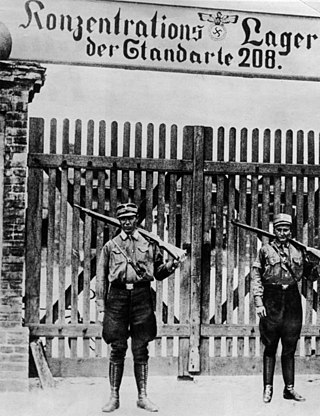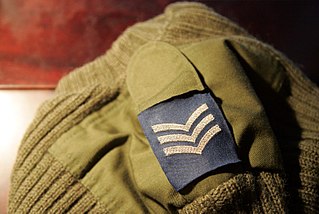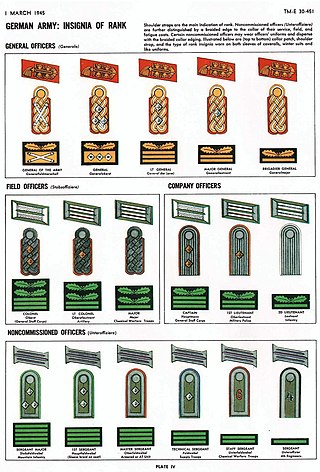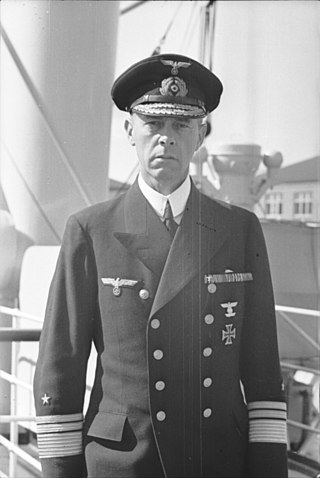
Epaulette is a type of ornamental shoulder piece or decoration used as insignia of rank by armed forces and other organizations. Flexible metal epaulettes are referred to as shoulder scales.
The United States Air Force officer rank insignia in use today.
The chart below shows the current enlisted rank insignia of the United States Army, with seniority, and pay grade, increasing from right to left. The enlisted ranks of corporal (E-4) and higher are considered non-commissioned officers (NCOs). The rank of specialist is also in pay grade E-4, but does not hold non-commissioned officer status; it is common that a soldier may never hold the rank of corporal, and instead be promoted from specialist to sergeant, attaining junior NCO status at that time.
Officer Cadet is a rank held by military cadets during their training to become commissioned officers. In the United Kingdom, the rank is also used by members of University Royal Naval Units, University Officer Training Corps and University Air Squadron; however, these are not trainee officers with many not choosing a career in the armed forces.

The uniforms and insignia of the Sturmabteilung (SA) were Nazi Party paramilitary ranks and uniforms used by SA stormtroopers from 1921 until the fall of Nazi Germany in 1945. The titles and phrases used by the SA were the basis for paramilitary titles used by several other Nazi paramilitary groups, among them the Schutzstaffel (SS). Early SS ranks were identical to the SA, since the SS was originally considered a sub-organization of the Sturmabteilung.

Imperial Japanese Army uniforms tended to reflect the uniforms of those countries who were the principal advisors to the Imperial Japanese Army at the time.

The uniform and insignia of the Boy Scouts of America (BSA) gives a Scout visibility and creates a level of identity within both the unit and the community. The uniform is used to promote equality while showing individual achievement. While all uniforms are similar in basic design, they do vary in color and detail to identify the different membership divisions of Cub Scouting, Scouts BSA and Venturing. Many people collect BSA insignia such as camporee and jamboree emblems, council shoulder strips and historical badges.
The United States Army in World War II used a variety of standard and non-standard dress and battle uniforms, which often changed depending upon the theater of war, climatic environment, and supply exigencies.

The uniforms of the United States Navy include dress uniforms, daily service uniforms, working uniforms, and uniforms for special situations, which have varied throughout the history of the navy. For simplicity in this article, officers refers to both commissioned officers and warrant officers.

In the United States Army, soldiers may wear insignia to denote membership in a particular area of military specialism and series of functional areas. Army branch insignia is similar to the line officer and staff corps officer devices of the U.S. Navy as well as to the Navy enlisted rating badges. The Medical, Nurse, Dental, Veterinary, Medical Service, Medical Specialist, Chaplains, and Judge Advocate General's Corps are considered "special branches", while the others are "basic branches".
United States Army commissioned officers rank insignia in use today.

The United States Marine Corps (USMC) prescribes several types of military uniform to distinguish its service members from other armed services, depending on the situation.

A shoulder mark, also called rank slide, or slip-on, is a flat cloth sleeve worn on the shoulder strap of a uniform. It may bear rank or other insignia. A shoulder mark should not be confused with a shoulder board, shoulder knot or epaulette, although these terms are often used interchangeably.
Star Trek uniforms are costumes worn by actors portraying personnel of a fictitious Starfleet in various television series and films in the Star Trek science fiction franchise. During the various series, the costume design has often changed to represent different time periods and for reasons of appearance and comfort. Sometimes different styles were deliberately mixed to enhance the sense of time travel or alternative universes.

In the German military, Waffenfarbe is a visual method that the armed forces use to distinguish between different corps or troop functions in its armed services. The Waffenfarbe itself can take the form of the color of the collar patch, of the piping (embellishment) around the shoulder boards or shoulder marks, or—for enlisted ranks—of the piping around the collar and the garrison cap (Schiffchen).

The uniforms of the United States Air Force are the standardized military uniforms worn by airmen of the United States Air Force to distinguish themselves from the other services.
The military uniforms of the Union Army in the American Civil War were widely varied and, due to limitations on supply of wool and other materials, based on availability and cost of materials. The ideal uniform was prescribed as a dark blue coat with lighter pants, with a black hat. Officer's ranks were denoted with increasing levels of golden decoration. Specific jobs, companies, and units had markedly different styles at times, often following European customs such as that of the Zouaves. Officers uniforms tended to be highly customized and would stray from Army standard. Ironically, several main pieces of gear had been created by order of the U.S. War Secretary Jefferson Davis before the war; he later became Confederate President.
Each branch of the Confederate States armed forces had its own service dress and fatigue uniforms and regulations regarding them during the American Civil War, which lasted from April 12, 1861, until May 1865.

The Heer as the German army and part of the Wehrmacht inherited its uniforms and rank structure from the Reichsheer of the Weimar Republic (1921–1935). There were few alterations and adjustments made as the army grew from a limited peacetime defense force of 100,000 men to a war-fighting force of several million men.

The Kriegsmarine was the navy of Nazi Germany prior to and during World War II. Kriegsmarine uniform design followed that of the preexisting Reichsmarine, itself based on that of the First World War Kaiserliche Marine. Kriegsmarine styles of uniform and insignia had many features in common with those of other European navies, all derived from the British Royal Navy of the 19th century, such as officers' frock coats, sleeve braid, and the "sailor suit" uniform for enlisted personnel and petty officers.



























































